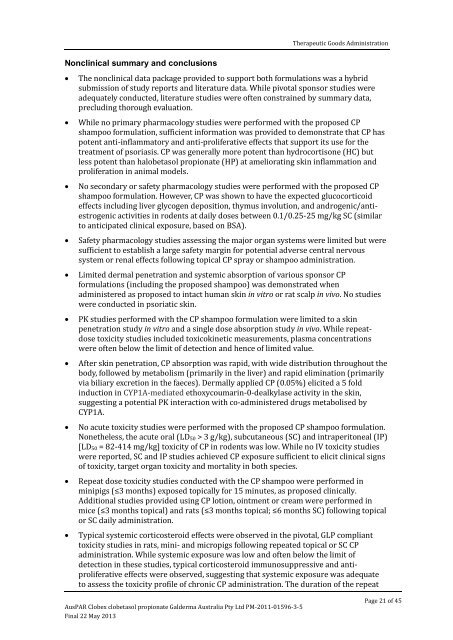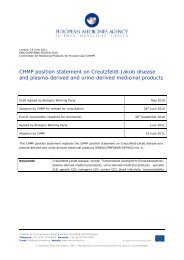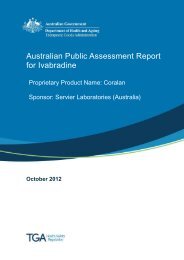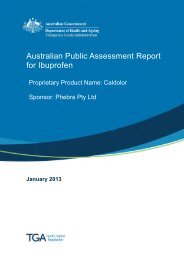AusPAR: Clobetasol propionate - Therapeutic Goods Administration
AusPAR: Clobetasol propionate - Therapeutic Goods Administration
AusPAR: Clobetasol propionate - Therapeutic Goods Administration
You also want an ePaper? Increase the reach of your titles
YUMPU automatically turns print PDFs into web optimized ePapers that Google loves.
<strong>Therapeutic</strong> <strong>Goods</strong> <strong>Administration</strong>Nonclinical summary and conclusions• The nonclinical data package provided to support both formulations was a hybridsubmission of study reports and literature data. While pivotal sponsor studies wereadequately conducted, literature studies were often constrained by summary data,precluding thorough evaluation.• While no primary pharmacology studies were performed with the proposed CPshampoo formulation, sufficient information was provided to demonstrate that CP haspotent anti-inflammatory and anti-proliferative effects that support its use for thetreatment of psoriasis. CP was generally more potent than hydrocortisone (HC) butless potent than halobetasol <strong>propionate</strong> (HP) at ameliorating skin inflammation andproliferation in animal models.• No secondary or safety pharmacology studies were performed with the proposed CPshampoo formulation. However, CP was shown to have the expected glucocorticoideffects including liver glycogen deposition, thymus involution, and androgenic/antiestrogenicactivities in rodents at daily doses between 0.1/0.25-25 mg/kg SC (similarto anticipated clinical exposure, based on BSA).• Safety pharmacology studies assessing the major organ systems were limited but weresufficient to establish a large safety margin for potential adverse central nervoussystem or renal effects following topical CP spray or shampoo administration.• Limited dermal penetration and systemic absorption of various sponsor CPformulations (including the proposed shampoo) was demonstrated whenadministered as proposed to intact human skin in vitro or rat scalp in vivo. No studieswere conducted in psoriatic skin.• PK studies performed with the CP shampoo formulation were limited to a skinpenetration study in vitro and a single dose absorption study in vivo. While repeatdosetoxicity studies included toxicokinetic measurements, plasma concentrationswere often below the limit of detection and hence of limited value.• After skin penetration, CP absorption was rapid, with wide distribution throughout thebody, followed by metabolism (primarily in the liver) and rapid elimination (primarilyvia biliary excretion in the faeces). Dermally applied CP (0.05%) elicited a 5 foldinduction in CYP1A-mediated ethoxycoumarin-0-dealkylase activity in the skin,suggesting a potential PK interaction with co-administered drugs metabolised byCYP1A.• No acute toxicity studies were performed with the proposed CP shampoo formulation.Nonetheless, the acute oral (LD 50 > 3 g/kg), subcutaneous (SC) and intraperitoneal (IP)[LD 50 = 82-414 mg/kg] toxicity of CP in rodents was low. While no IV toxicity studieswere reported, SC and IP studies achieved CP exposure sufficient to elicit clinical signsof toxicity, target organ toxicity and mortality in both species.• Repeat dose toxicity studies conducted with the CP shampoo were performed inminipigs (≤3 months) exposed topically for 15 minutes, as proposed clinically.Additional studies provided using CP lotion, ointment or cream were performed inmice (≤3 months topical) and rats (≤3 months topical; ≤6 months SC) following topicalor SC daily administration.• Typical systemic corticosteroid effects were observed in the pivotal, GLP complianttoxicity studies in rats, mini- and micropigs following repeated topical or SC CPadministration. While systemic exposure was low and often below the limit ofdetection in these studies, typical corticosteroid immunosuppressive and antiproliferativeeffects were observed, suggesting that systemic exposure was adequateto assess the toxicity profile of chronic CP administration. The duration of the repeat<strong>AusPAR</strong> Clobex clobetasol <strong>propionate</strong> Galderma Australia Pty Ltd PM-2011-01596-3-5Final 22 May 2013Page 21 of 45
















